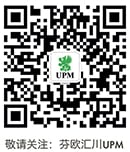Several decades of combined expertise in recyclability
Our team consists of seven lab technicians and three scientists, the latter of which includes me. Our strong industrial and scientific background collectively covers experience from the paper and textile industries to forestry and biology. In Augsburg, we have all the necessary equipment to simulate a paper mill’s recycling and deinking process on a small scale.
For developing recyclable products and recyclability evaluation, you benefit from understanding the industrial recycling processes and what affects them. It always begins with the collection of post-consumer paper and is followed by sorting these materials into separate fractions for further recycling. Our good network helps us to understand the full process, especially as there is variation in the collection and sorting systems in different countries. As a large users of recycled paper, UPM not only has in-depth recycling knowledge but also understands practical factors affecting the recyclability of paper.
At our site, we can perform various tasks related to recyclability. The wet and paper labratoryallows us to create a fibre pulp from pre-consumer and post-consumer paper and board products, and process the pulp with e.g. screening, flotation and bleaching. Laboratory paper sheets are made and used to study the mechanical and optical properties, as well as cleanliness. Infrared spectroscopy and microscopy is used to analyse the type of a potential contamination with, e.g. printing ink particle or glues.
We can perform all the recyclability assessments required at the European level, such as those published in 2021 and 2022 by Cepi - the European association representing the paper industry – and the 4evergreen alliance, the PTS recyclability test, as well as INGEDE test methods.
UPM in member of the cross-industry alliance 4evergreen, which was initiated by Cepi. It is developing the whole value chain of paper and board-based packaging and aims to achieve a 90 percent recycling rate of fibre-based packaging by 2030 throughout Europe
Recycling as part of the product design
UPM Specialty paper uses many internal recyclability tests during the paper product design and development phase and considers and optimizes the papers behaviour in sorting lines and its recyclability. If you would produce something that is sorted into a fraction which can’t be recycled, then you get no value out of the material. Finally, all grades are tested by external accredited laboratories to ensure the official certification, which all UPM Specialty grades have.
For example, we tested the recyclability of UPM Specialty Papers’ UPM Confidio™ family of new barrier papers that were launched in 2022. Even though heat-sealing properties were innovatively combined with moisture and grease resistance barriers, the UPM Confidio™ paper grades can still be recycled from household paper and board collection systems.
Partners further process the UPM paper to new packaging materials in co-creation projects. UPM supports the partners with numerous recyclability tests and expertise during the development phase to ensure that the new products can also be recycled.
Recyclability has long been a key design priority for UPM and we are well-prepared for any legislative changes. Once all the rules are stricter, the winners will be the companies that adapt quickly and fit into the future scheme.
